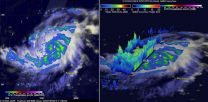Satellite mapping reveals agricultural slowdown in Latin America: UBC study
2015-05-13
(Press-News.org) For the first time, satellite mapping of Latin America shows that the continent's agricultural expansion has waned in the wake of the global economic downturn, according to UBC research.
"Nearly every agricultural region across Latin America slowed down in expansion from 2007 to 2013, compared to the previous six years," says Jordan Graesser, the study's lead author. Graesser is a visiting international student at UBC's Liu Institute for Global Issues and the Institute for Resources, Environment and Sustainability.
The study, recently published in Environmental Research Letters, involved the first large-scale mapping of changes in cropland and pastureland over more than a decade at the continental scale, using satellite imagery.
The slowdown is notable, given that agriculture in Latin America expanded faster over the past few decades compared to any other region on earth. The growth was fuelled by the continent's "Green Revolution" in the 1960s, where agricultural innovations, such as the development of new seeds, increased crop yields.
But the agricultural decline revealed by the study may not last. "Agriculture in Latin America is tied to global commodity prices," says Graesser, also a PhD student at McGill University's Department of Geography. "So if the global economy continues to recover, and if crop prices increase, there's likely going to be more expansion - which could impact biodiversity and boost carbon emissions."
Soy production is the key driver of cropland expansion in South America. Much of the soy grown there is used to feed poultry and pigs in China, where the consumption of meat has surged as the population gains affluence. Pasture expansion is driven by the growth of beef cattle production, fueled by exports to Europe and increasing domestic consumption.
Biofuels are another driver of cropland expansion in some Latin American countries. For example, sugarcane from Brazil is used for biofuel production.
INFORMATION:
BACKGROUND
The study, "Cropland/pastureland dynamics and the slowdown of deforestation in Latin America," is published in Environmental Research Letters. Graesser's co-authors are T. Mitchell Aide from the University of Puerto Rico, H. Ricardo Grau from the Universidad Nacional de Tucumán and Navin Ramankutty from UBC's Liu Institute for Global Issues and the Institute for Resources, Environment and Sustainability.
The study used 13 years (2001-2013) of satellite imagery to quantify cropland and pastureland expansion across Latin America. Cropland, the more intensive practice, refers to the growing of row crops such as soy, maize, wheat and cotton. Pastureland refers to grassland ecosystems that are grazed by livestock - primarily beef cattle in Latin America.
Brazil's Cerrado and Atlantic Forest regions, and Argentina's Humid Pampas region, experienced the greatest increase in new cropland from 2001-2013. The southern and eastern borders of the Brazilian Amazon and the Dry Chaco region (the latter stretches across Paraguay, Bolivia, Argentina and Brazil) had the largest amount of new pastureland.
ELSE PRESS RELEASES FROM THIS DATE:
2015-05-13
ITHACA, N.Y. -- If you're planning to fly over the holiday, plan to drink some tomato juice. While examining how airplane noise affects the palate, Cornell University food scientists found sweetness suppressed and a tasty, tender tomato surprise: umami.
A Japanese scientific term, umami describes the sweet, savory taste of amino acids such as glutamate in foods like tomato juice, and according to the new study, in noisy situations -- like the 85 decibels aboard a jetliner -- umami-rich foods become your taste bud's best buds.
"Our study confirmed that in an environment ...
2015-05-13
PITTSBURGH -- A research team led by the University of Pittsburgh's Jeremy Levy has discovered electrons that can "swing dance." This unique electronic behavior can potentially lead to new families of quantum devices.
Superconductors, materials that permit electrical current to flow without energy loss, form the basis for magnetic resonance imaging devices as well as emerging technologies such as quantum computers. At the heart of all superconductors is the bunching of electrons into pairs.
Levy, Distinguished Professor of Physics and Pittsburgh Quantum Institute director, ...
2015-05-13
The type of perfectionist who sets impossibly high standards for others has a bit of a dark side. They tend to be narcissistic, antisocial and to have an aggressive sense of humor. They care little about social norms and do not readily fit into the bigger social picture. So says Joachim Stoeber of the University of Kent in the UK, who compared the characteristics of so-called other-orientated perfectionists against those of perfectionists who set the bar extremely high for themselves. The study is published in Springer's Journal of Psychopathology and Behavioral Assessment.
Perfectionism ...
2015-05-13
Typhoon Dolphin (strengthened overnight on 5/12 from Tropical Storm status) formed south of Pohnpei in the western Pacific Ocean on May 7, 2015. Dolphin's power has oscillated from a weak tropical depression to typhoon intensity over the past five days. Dolphin is now an intensifying typhoon headed westward.
The GPM core observatory satellite flew over Dolphin on May 12, 2015 at 2301 UTC. At that time Dolphin's wind speeds were estimated at about 65 kts (75 mph). Rainfall collected by GPM's Microwave Imager (GMI) showed that rain was falling at a rate of over 47 mm (1.9 ...
2015-05-13
As murder mysteries go, it's a big one: how do galaxies die and what kills them? A new study, published today in the journal Nature, has found that the primary cause of galactic death is strangulation, which occurs after galaxies are cut off from the raw materials needed to make new stars.
Researchers from the University of Cambridge and the Royal Observatory Edinburgh have found that levels of metals contained in dead galaxies provide key 'fingerprints', making it possible to determine the cause of death.
There are two types of galaxies in the Universe: roughly half ...
2015-05-13
If you walk into a dark room, you can still find your way to the light switch. That's because your brain keeps track of landmarks and the direction in which you are moving. Fruit flies also boast an internal compass that works when the lights go out, scientists at the Howard Hughes Medical Institute's Janelia Research Campus have discovered. Their findings suggest that dissecting how fruit flies navigate through the world could help researchers understand how humans and other mammals achieve that task.
In our brains, several kinds of neurons help us get and keep our bearings. ...
2015-05-13
Humans concerned about climate change are working to find ways of capturing excess carbon dioxide (CO2) from the atmosphere and sequestering it in the Earth. But Nature has its own methods for the removal and long-term storage of carbon, including the world's river systems, which transport decaying organic material and eroded rock from land to the ocean.
While river transport of carbon to the ocean is not on a scale that will bail humans out of our CO2 problem, we don't actually know how much carbon the world's rivers routinely flush into the ocean - an important piece ...
2015-05-13
Antipsychotic medication use during pregnancy does not put women at additional risk of developing gestational diabetes, hypertensive disorders or major blood clots that obstruct circulation, according to a new study led by researchers at Women's College Hospital and the Institute for Clinical Evaluative Sciences (ICES).
The study, published today in BMJ, is the largest to date to examine possible links between newer antipsychotic medications -- such as quetiapine, olanzapine and risperidone -- and medical conditions that often develop during pregnancy or with use of older ...
2015-05-13
Fermions are the building blocks of matter, interacting in a multitude of permutations to give rise to the elements of the periodic table. Without fermions, the physical world would not exist.
Examples of fermions are electrons, protons, neutrons, quarks, and atoms consisting of an odd number of these elementary particles. Because of their fermionic nature, electrons and nuclear matter are difficult to understand theoretically, so researchers are trying to use ultracold gases of fermionic atoms as stand-ins for other fermions.
But atoms are extremely sensitive to ...
2015-05-13
Pregnant women who undergo general surgical procedures appear to have no significant difference in postoperative complications compared with women who are not pregnant, according to a report published online by JAMA Surgery.
Historical data show that about 1 in 500 pregnant women require nonobstetric surgery, according to the study background.
Robert A. Meguid, M.D., M.P.H., of the University of Colorado Anschutz Medical Campus, Aurora, and coauthors analyzed data from the American College of Surgeons' National Surgical Quality Improvement Program from 2006 through ...
LAST 30 PRESS RELEASES:
[Press-News.org] Satellite mapping reveals agricultural slowdown in Latin America: UBC study

